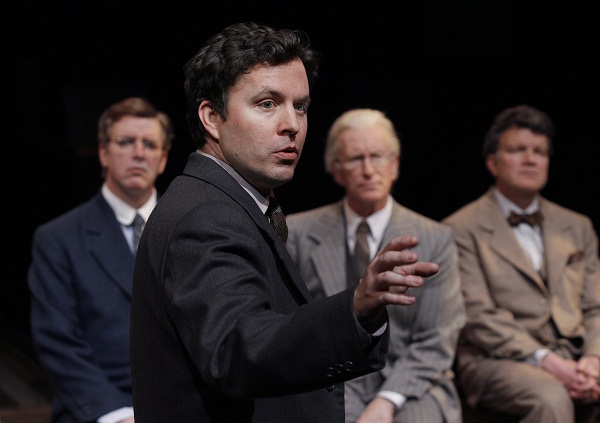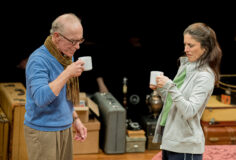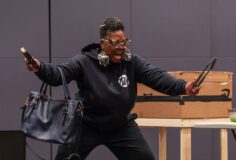Review: “The Pitmen Painters” by Lee Hall. Directed by Kurt Beattie. With Daniel Brockley, Christine Marie Brown, Frank Lawler, Charles Leggett, Jason Marr, Joseph P. McCarthy, Morgan Rowe, and R. Hamilton Wright. Now through May 20, 2012 at ACT.

Jason Marr in the foreground. Charles Leggett, R. Hamilton Wright, and Frank Lawler in the background. Photo: Chris Bennion
Damn you, ACT and your currently running play, “The Pitmen Painters”!
Mr. Strangeways does NOT like showing emotion, EVUH, and he certainly doesn’t like showing emotion in PUBLIC, yet your production of Lee Hall’s incredibly beautiful and moving play about a group of British coal miners and the art they created during the 1930’s and 40’s FREQUENTLY had me in tears. Maybe it was the expert direction by Kurt Beattie, or the fine design work by Carey Wong (Sets), Catherine Hunt (Costumes), Ben Zamora (Lighting), and Brendan Patrick Hogan (Sound). Very likely it was the exquisite acting by a company that includes Morgan Rowe, R. Hamilton Wright, Frank Lawler and the exceptionally excellent work by Jason Marr as the primary protagonist, Oliver Kilbourn. Regardless, of who is specifically to blame/praise, I’m still chagrined to admit to weeping at the lyrical beauty of your production. “The Pitmen Painters” is a bittersweet ode to art and the eternal struggle of the working class and while it teeters occasionally into the sentimental, it’s still a major work of art from writer Lee Hall, and a powerful theater experience. Currently, it’s the best main stage play on a Seattle stage and you should not miss it.
It’s also largely based on fact. In 1934, at the height of the worldwide Great Depression, the Ashington branch of the Worker’s Education Association, a self-improvement body created by the British miner’s union, started a class in art appreciation taught by Robert Lyon, a master of painting from nearby Durham University. The upper crust Lyon had a difficult time connecting with his working class students and decided the best course of action was to have the men CREATE art, in order to better understand it. Many of the men displayed an astonishing aptitude for painting, and the Ashington Group, as they came to be called, soon became the darling of artistic circles with gallery shows in London and elsewhere. Playwright Lee Hall, using a non-fiction book by William Feaver as source material, created “The Pitmen Painters” balancing the creation of the art with the struggle of the working class to integrate into the hyper class conscious British society.
“The Pitmen Painters” is an ensemble show with 8 actors playing 9 roles and many of the scenes are group scenes involving Lyon teaching the 5 men in his class. (The actual class was larger.) But the play subtly begins to focus on one of the pitmen: Oliver Kilbourn, a soft spoken but passionate younger miner who’s been in the pits since he was a young teen in an effort to support his family. Kilbourn displays a strong talent and praise from both his instructor, Lyon, and Helen Sutherland, a wealthy arts supporter, encourages him to begin dreaming that he could be a professional artist. Kilbourn’s journey as an artist becomes a primary focus of the play, but the most moving aspects of “Pitmen” are the scenes involving Kilbourn, and the other men, as they begin to examine and question the meaning of art…what art MEANS to both the individual and the group, and how socio-economic class divisions affect both the art and the artist. Mr. Hall’s beautifully written scenes and dialogue will move anyone who loves the creation of art, but there’s always a sense of socialist anger at the inequalities that divide the rich and poor. And, the final moments of the play are a powerful indictment at the failures of society, and the Labour Movement in Britain in particular, to address these issues.
It’s a terrific play, with many brilliantly written moments and it’s all well staged by ACT’s Artistic Director Kurt Beattie. He’s aided by a superb cast of Seattle actors with R. Hamilton Wright as the non-miner outsider in the group, Harry Brown; Daniel Brockley in two roles as a young unemployed student in the group and doubling as an established, upper class painter of note in a later scene; and Charles Leggett as the dogmatic and rigid group leader, George Brown.
As the upper class characters, the instructor Robert Lyon, and the wealthy patroness Helen Sutherland, both Frank Lawler and Morgan Rowe give exceptional performances (and perfect accents) as sympathetic allies of the men. Mr. Lawler was particularly good as a man who has to somewhat bitterly realize that his some of his non-educated, working class students have a stronger artistic gift than his own. Ms Rowe is regally sympathetic (and a trifle high handed) as a benefactor who has strong feelings for the group, and in particular, Oliver Kilbourn. It’s lovely work from both actors.
But, the shining star of “The Pitmen Painters” is Jason Marr as Oliver. It’s a subtle and beautifully nuanced performance of a character yearning to break free of his old life, but terrified of making the leap to another. Mr. Marr does superb work conveying the many layers of a man who’s always been reticent to express any emotion and the moment when he’s realized he’s made the wrong choice, is just heart breaking. It’s an excellent performance and one of my favorites of the year.
One quick note of the less favorable kind: the working class accents are a bit…rough. (I’m not the only one to think so; British friends of mine also commented on this to me.) To be fair, strictly accurate working class accents from the north of England would be practically incomprehensible to the majority of Americans, but there’s some glaring inconsistencies in some of the performances. Some of the actors barely attempt an accent, and others tend to bounce back and forth. I won’t name names and it doesn’t ruin the production, but it should be noted. (But, the “RP” accents of the upper class characters all received high marks from my British friends.)
And, many of the actual works of the “Pitmen” are displayed on video screens on opposite sides of the stage, (or, to be more accurate, copies of their paintings) and it’s a major and vital visual element of the production. The paintings themselves become primary characters in the play. Jane Richlovsky and Lara Kaminsky are credited as Visual Arts Coach & Consultant and Associate Designer for Media, so I’m assuming they had a major role in the art display, so kudos to them both.
Who’s this for? Artists. People who love art. People who love beautifully lyrical and profound theater.
It’s a must see.
Even though they made me cry in public.













